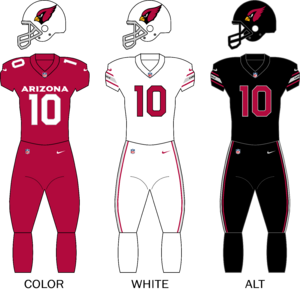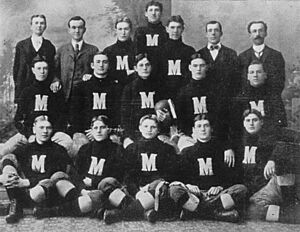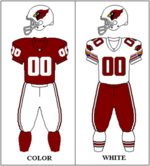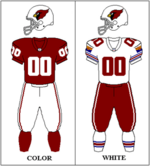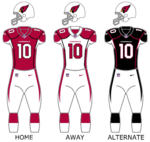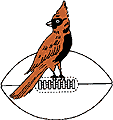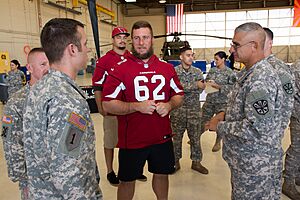Arizona Cardinals facts for kids
Quick facts for kids Arizona Cardinals |
|||||||||||||
|---|---|---|---|---|---|---|---|---|---|---|---|---|---|
|
|||||||||||||
| Basic info | |||||||||||||
| Established | 1898 | ||||||||||||
| Stadium | State Farm Stadium, Glendale, Arizona | ||||||||||||
| Headquartered | Tempe, Arizona | ||||||||||||
| Colors | Cardinal red, white, black, silver |
||||||||||||
| Mascot | Big Red | ||||||||||||
| Personnel | |||||||||||||
| Owner(s) | Michael Bidwill | ||||||||||||
| Chairman | Michael Bidwill | ||||||||||||
| President | Michael Bidwill | ||||||||||||
| General manager | Monti Ossenfort | ||||||||||||
| Head coach | Jonathan Gannon | ||||||||||||
| Nicknames | |||||||||||||
|
|||||||||||||
| Team history | |||||||||||||
|
|||||||||||||
| Home fields | |||||||||||||
Temporary stadiums
1944 due to shortage of players during World War II (temporary merger with Pittsburgh Steelers):
1959 before relocation to St. Louis:
|
|||||||||||||
| League / conference affiliations | |||||||||||||
| Independent (1898–1906, 1913–1919) National Football League (1920–present)
|
|||||||||||||
| Championships | |||||||||||||
League championships: 2
|
|||||||||||||
Conference championships: 1
|
|||||||||||||
Division championships: 7
|
|||||||||||||
| Playoff appearances (11) | |||||||||||||
|
|||||||||||||
| Owner(s) | |||||||||||||
|
|||||||||||||
The Arizona Cardinals are a professional American football team. They are based in the Phoenix metropolitan area in Arizona. The Cardinals play in the National Football League (NFL). They are part of the National Football Conference (NFC) West division. Their home games are played at State Farm Stadium in Glendale. Glendale is a suburb northwest of Phoenix.
The team started in Chicago in 1898 as the Morgan Athletic Club. They joined the NFL as a founding member on September 17, 1920. The Cardinals are the oldest continuously running professional football team in the United States. They are one of only two NFL founding teams still playing today, the other being the Chicago Bears.
In 1960, the team moved to St. Louis. There, they were often called the "Football Cardinals" or "Big Red." This helped avoid confusion with the Major League Baseball team, the St. Louis Cardinals. Before the 1988 season, the team moved to Tempe, Arizona. They played at Sun Devil Stadium for 18 seasons. In 2006, they moved to their current home in Glendale. Their main offices and training area are still in Tempe.
The Cardinals have won two NFL championships. Both wins happened when the team was in Chicago. The first win in 1925 was debated by some. Their second championship in 1947 was won in a championship game. This was almost 20 years before the first Super Bowl. They played in the championship game again in 1948 but lost.
The team has had many losing seasons since then. As of 2024, they have the longest championship drought in North American sports. This means they haven't won a championship in 77 seasons. The Cardinals also have the most losses in NFL history. They have been to the playoffs 11 times. They have won seven playoff games. This includes three wins in the 2008–09 playoffs. That season, they won their only NFC Championship Game since 1970. They reached Super Bowl XLIII but lost to the Pittsburgh Steelers 27–23.
The team has won five division titles. These were in 1974, 1975, 2008, 2009, and 2015. The Cardinals are the only NFL team that has never lost a playoff game at home. Their home playoff record is 5–0. Since moving to the Phoenix area in 1988, they have made six playoff appearances. They also have three division titles and one NFC championship.
Contents
Team History
Early Years in Chicago (1920–1959)
The team started in 1898 as the Morgan Athletic Club in Chicago. Chris O'Brien, a contractor, bought the team. He moved them to Normal Field. They were called the Racine Normals until 1901. That year, O'Brien bought used jerseys from the University of Chicago. He said the faded maroon jerseys looked "Cardinal red." So, the team became the Racine Street Cardinals.
In 1920, the team became a founding member of the American Professional Football Association (APFA). This league later became the NFL. They were called the Racine Cardinals. In 1922, they changed their name to the Chicago Cardinals. This was to avoid confusion with another team.
NFL Champions in 1925
In 1925, the Cardinals were given the NFL Championship. This happened after another team, the Pottsville Maroons, was suspended. The Maroons had played a game in another team's area. The Cardinals also broke NFL rules by playing extra games. One game even used high school players.
NFL Champions in 1947
After World War II, the team played in two NFL finals against the Philadelphia Eagles. They won in 1947 but lost in 1948. By the late 1950s, the team was struggling. They were losing fans to the Chicago Bears. The owner, Violet Bidwill Wolfner, wanted to move the team.
Moving to St. Louis (1960–1987)
The NFL allowed the team to move to St. Louis, Missouri. They became the St. Louis Cardinals. People called them "Big Red" or "Football Cardinals." This was to tell them apart from the local baseball team.
During their 28 years in St. Louis, they made the playoffs only three times. They never hosted or won a playoff game. They did win the Playoff Bowl in 1964. This was a game for third place. The team's average performance and an old stadium led to fewer fans. So, owner Bill Bidwill decided to move the team to Arizona.
Phoenix and Arizona Cardinals (1988–Present)
After the 1987 NFL season, the team moved to Phoenix. They were called the Phoenix Cardinals. On March 17, 1994, they changed their name to the Arizona Cardinals.
In 1998, the Cardinals made the playoffs for the first time in 16 years. They won their first playoff game since 1947. They beat the Dallas Cowboys 20–7. Their playoff run ended with a loss to the Minnesota Vikings.
In 2008, led by quarterback Kurt Warner, the Cardinals had a great playoff run. They won the Wild Card, Divisional, and NFC Championship games. This sent them to the Super Bowl for the first time. They lost Super Bowl XLIII 27–23 to the Pittsburgh Steelers.
The Cardinals had a 10–6 record in 2009. This was their first 10-win season in Arizona. They won their second straight NFC West title. However, they lost to the New Orleans Saints in the playoffs.
In 2014, they made the playoffs as a wild card team. They had their best regular-season record in Arizona at 11–5. But they lost to the Carolina Panthers. The next year, in 2015, the Cardinals had a franchise-best 13–3 record. They earned a first-round playoff bye. They beat the Green Bay Packers in overtime. This was quarterback Carson Palmer's first playoff win. They reached their second NFC Championship Game. But they lost to the Panthers 49–15.
The team's performance declined in the following years. In 2021, the Cardinals went 11–6. They returned to the playoffs but lost to the Los Angeles Rams. In 2022 and 2023, they finished with a 4–13 record.
Team Look: Logos and Uniforms
Since 1947, the team's logo has been a Northern cardinal bird. It was shown sitting on the laces of a football.
When the Cardinals moved to Arizona in 1988, the flag of Arizona was added to their uniform sleeves. In 1990, they started wearing red pants with their white jerseys. This was to look like the Washington Redskins.
In 1994, the Cardinals wore special throwback uniforms for the NFL's 75th anniversary. These jerseys looked like the 1920s Chicago Cardinals. They had an "CC" logo and stripes on the sleeves. The pants were khaki.
The cardinal head on the helmet also appeared on the white jersey sleeve until 1995. In 1996, the Arizona state flag moved higher on the sleeve. Black was removed as a color, replaced with blue to match the flag. In 2002, the Cardinals started wearing all-red and all-white uniforms.
In 2005, the team changed its look a lot. The cardinal-head logo was updated to look more modern. Black became an accent color again. New lines were added to the jerseys and pants. Both red and white jerseys could be worn with red or white pants.
The Cardinals used to wear white jerseys at home during the first half of the season. This was to make opponents wear darker jerseys in the Arizona heat. But when they moved to State Farm Stadium in 2006, the roof could be closed. This kept the temperature cool inside. So, the team started wearing red jerseys at home all the time.
In 2010, the Cardinals introduced a new black alternate jersey. In 2017, they debuted an all-black uniform for the NFL Color Rush program. These had red lettering and black pants. Starting in 2022, both black uniforms were worn with a black helmet.
Before the 2023 season, the Cardinals showed off new uniforms. They now wear all-red at home and all-white on the road. All-black is their alternate uniform. The red uniform has the state name on the front. The white uniform has red numbers with black trim. The black uniform looks similar to the white one. Both red and white uniforms use white helmets. The black uniform uses the black helmets from 2022.
Fans and Community
Cardinals fans are very loyal, even with the team's long championship drought. Some fans believe a "curse" exists because of a dispute over the 1925 NFL title. Fans of the Cardinals are often called the Red Sea or the Bird Gang. Famous fans include Blake Shelton and Jordin Sparks.
The Cardinals have a strong connection with the military. This is partly in honor of former safety Pat Tillman, who died serving his country. The team often works with military members. They visit Luke Air Force Base to support servicemen.
Team Rivalries
Divisional Rivals
Los Angeles Rams
This is the oldest and most intense rivalry for the Cardinals. The teams first played in 1937. Both teams have played in St. Louis at different times. The rivalry has become strong again as both teams have had playoff success. The Rams have won many games against the Cardinals since 2017. The Rams lead the series 50–40–2. They also lead 2–0 in playoff games.
Seattle Seahawks
This is a newer rivalry. The Cardinals and Seattle Seahawks became division rivals in 2002. This rivalry has become very competitive. In the mid-2010s, the Seahawks and Cardinals often competed for the NFC West title. Seattle leads the series 25–22–1. The two teams have not yet met in the playoffs.
San Francisco 49ers
The Cardinals and 49ers first met in 1951. They became full rivals in 2002. This rivalry can be very one-sided at times. The 49ers won nine of ten games between 2009 and 2013. Then, the Cardinals won eight straight games between 2014 and 2018. The 49ers lead the series 34–29. They have not met in the playoffs.
Historic Rivals
Chicago Bears
This rivalry is historic because both teams are from the NFL's start in 1920. The Bears were then called the Decatur Staleys. The Cardinals were the Racine Cardinals. For 38 years, their games were known as "The Battle of Chicago." This was the league's first true rivalry. The Bears lead the all-time series 59–29–6.
Team Records
Single-Season Records
- Points Scored: 489 (2015)
- Passing Yards: 4,671 – Carson Palmer (2015)
- Passing Touchdowns: 35 – Carson Palmer (2015)
- Rushing Yards: 1,605 – Ottis Anderson (1979)
- Rushing Touchdowns: 16 – David Johnson (2016)
- Receptions: 109 – Larry Fitzgerald (2015)
- Receiving Yards: 1,598 – David Boston (2001)
- Receiving Touchdowns: 15 – Sonny Randle (1960)
- Field Goals: 40 – Neil Rackers (2005)
Career Records
- Passing Yards: 34,639, Jim Hart (1966–1983)
- Passing Touchdowns: 209, Jim Hart (1966–1983)
- Rushing Yards: 7,999, Ottis Anderson (1979–1986)
- Rushing Touchdowns: 46, Ottis Anderson (1979–1986)
- Receptions: 1,432, Larry Fitzgerald (2004–2020)
- Receiving Yards: 15,545, Larry Fitzgerald (2004–2020)
- Interceptions: 52, Larry Wilson (1960–1972)
- Field Goals Made: 282, Jim Bakken (1962–1978)
- Total Touchdowns: 110, Larry Fitzgerald (2004–2020)
- Sacks: 71.5, Chandler Jones (2016–2021)
Players and Staff
Retired Numbers
The Cardinals have retired several jersey numbers to honor special players.
| Chicago / St. Louis / Arizona Cardinals Retired Numbers | ||||
| No. | Player | Position | Years Played | Retired |
|---|---|---|---|---|
| 8 | Larry Wilson | Safety | 1960–1972 | 1970 |
| 40 | Pat Tillman | Safety | 1998–2001 | 2004 |
| 77 | Stan Mauldin | Offensive Tackle | 1946–1948 | 1948 |
| 88 | J. V. Cain | Tight End | 1974–1978 | 1979 |
| 99 | Marshall Goldberg1 | Halfback | 1939–1943, 1946–1948 | 1948 |
Notes:
- Even though #99 is retired, J. J. Watt wore it in 2021 and 2022. This was allowed by Marshall Goldberg's daughter.
Pro Football Hall of Famers
Many great Cardinals players and coaches are in the Pro Football Hall of Fame.
| Chicago / St. Louis / Arizona Cardinals in the Pro Football Hall of Fame | ||||
| Players | ||||
|---|---|---|---|---|
| No. | Player | Position(s) | Years Played | Inducted |
| 4 | Ernie Nevers | Fullback | 1929–1931 | 1963 |
| 3 | Jim Thorpe | Running Back | 1928 | 1963 |
| 13 | Guy Chamberlin | End & Coach | 1927–1928 | 1965 |
| 1 | John "Paddy" Driscoll | Quarterback | 1920–1925 | 1965 |
| 62, 2 | Charley Trippi | Running Back | 1947–1955 | 1968 |
| 33 | Ollie Matson | Running Back | 1952, 1954–1958 | 1972 |
| 81 | Dick "Night Train" Lane | Cornerback | 1954–1959 | 1974 |
| 8 | Larry Wilson | Safety | 1960–1972 | 1978 |
| 81 | Jackie Smith | Tight End | 1963–1977 | 1994 |
| 72 | Dan Dierdorf | Offensive Tackle | 1971–1983 | 1996 |
| 22 | Roger Wehrli | Cornerback | 1969–1982 | 2007 |
| 35 | Aeneas Williams | Cornerback | 1991–2000 | 2014 |
| 13 | Kurt Warner | Quarterback | 2005–2009 | 2017 |
| 32 | Edgerrin James | Running Back | 2006–2008 | 2020 |
| 16 | Duke Slater | Tackle | 1926–1931 | 2020 |
| Coaches and Other Important People | ||||
| Name | Position(s) | Years with Team | Inducted | |
| Jimmy Conzelman | Coach | 1940–1942, 1946–1948 | 1964 | |
| Charles Bidwill | Team Owner | 1933–1947 | 1967 | |
Italics = played part of their career with the Cardinals but are mainly known for another team.
Ring of Honor
The Cardinals' Ring of Honor started in 2006. It celebrates great players from all parts of the team's history.
| Elected to the Pro Football Hall of Fame |
| Arizona Cardinals Ring of Honor | ||||
|---|---|---|---|---|
| No. | Name | Position(s) | Seasons | Inducted |
| — | Charles Bidwill | Owner | 1933–1947 | August 12, 2006 |
| — | Jimmy Conzelman | Coach | 1940–1942, 1946–1948 | |
| 1 | John "Paddy" Driscoll | QB Coach |
1920–1925 | |
| 99 | Marshall Goldberg | HB | 1939–1943, 1946–1948 | |
| 81 | Dick "Night Train" Lane | CB | 1954–1959 | |
| 33 | Ollie Matson | HB | 1952, 1954–1958 | |
| 4 | Ernie Nevers | FB Coach |
1929–1931 | |
| 62, 2 | Charley Trippi | HB/QB | 1947–1955 | |
| 8 | Larry Wilson | S | 1960–1972 | September 10, 2006 |
| 72 | Dan Dierdorf | T | 1971–1983 | October 16, 2006 |
| 40 | Pat Tillman | S | 1998–2001 | November 12, 2006 |
| 22 | Roger Wehrli | CB | 1969–1982 | October 14, 2007 |
| 35 | Aeneas Williams | CB | 1991–2000 | November 10, 2008 |
| 13 | Kurt Warner | QB | 2005–2009 | June 18, 2014 |
| 22, 24 | Adrian Wilson | S | 2001–2012 | September 27, 2015 |
| 25, 81 | Roy Green | WR | 1979–1990 | October 2, 2016 |
| 7, 17 | Jim Hart | QB | 1966–1983 | December 3, 2017 |
| 3 | Carson Palmer | QB | 2013–2017 | September 29, 2019 |
Current Staff
|
→ Coaching staff |
|||||
Radio and TV Broadcasts
The Cardinals' main radio station is KMVP-FM. Dave Pasch, Ron Wolfley, and Paul Calvisi are the announcers. Spanish-language radio broadcasts are on KQMR/KHOV-FM. Luis Hernandez and Rolando Cantú are the Spanish broadcast team. The Cardinals were the first NFL team to offer all their games in Spanish. They have a large network of stations in Mexico.
Since 2024, KTVK and KPHO broadcast the team's preseason games on TV.
See also
 In Spanish: Arizona Cardinals para niños
In Spanish: Arizona Cardinals para niños



